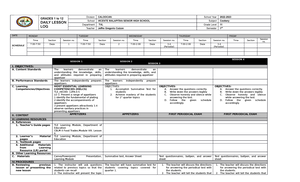- Information
- AI Chat
1-Example - Describing biology
BSE Science
University of Caloocan City
Recommended for you
Preview text
#1 Example: 2/9 of the people on a restaurant are adults. If there are 95 more children than adults, how many children are there in the restaurant?
Solution: Draw a diagram with 9 equal parts: 2 parts to represent the adults and 7 parts to represent the children.
5 units = 95 1 unit = 95 ÷ 5 = 19 7 units = 7 × 19 = 133
Answer: There are 133 children in the restaurant.
#2 Example: Gary and Henry brought an equal amount of money for shopping. Gary spent $95 and Henry spent $350. After that Henry had 4/7 of what Gary had left. How much money did Gary have left after shopping?
Solution:
350 – 95 = 255
3 units = 255
1 unit = 255 ÷ 3 = 85 7 units = 85 × 7 = 595
Answer: Gary has $595 after shopping.
#3 Example: 1/9 of the shirts sold at Peter’s shop are striped. 5/8 of the remainder are printed. The rest of the shirts are plain colored shirts. If Peter’s shop has 81 plain colored shirts, how many more printed shirts than plain colored shirts does the shop have?
Solution: Draw a diagram with 9 parts. One part represents striped shirts. Out of the remaining 8 parts: 5 parts represent the printed shirts and 3 parts represent plain colored shirts.
3 units = 81 1 unit = 81 ÷ 3 = 27 Printed shirts have 2 parts more than plain shirts. 2 units = 27 × 2 = 54
Answer: Peter’s shop has 54 more printed colored shirts than plain shirts.
Solve a problem involving fractions of fractions and fractions of remaining parts
Example: 1/4 of my trail mix recipe is raisins and the rest is nuts. 3/5 of the nuts are peanuts and the rest are almonds. What fraction of my trail mix is almonds?
The following are some examples of 6th Grade Math Word Problems that deals with ratio and fractions. These word problems are solved with the help of block diagrams or bar models (used in Singapore Math).
Example:
Adeline’s salary is of Connie’s salary.
a) Find the ratio of Adeline’s salary to Connie’s salary. b) Find the ratio of Connie’s salary to Adeline’s salary to their total salary.
Solution:
Total number of units = 5 + 2 = 7
From the model, we see that. a) The ratio of Adeline’s salary to Connie’s salary is 5:2. b) The ratio of Connie’s salary to Adeline’s salary to their total salary is 2:5:7.
Example:
Joanne’s savings is 4 times as much as Pam’s savings.
a) What is the ratio of Joanne’s savings to Pam’s savings to their total savings? b) What fraction of their total savings is Joanne’s savings? c) What fraction of Joanne’s savings is Pam’s savings? d) If both girls save a total of $120, how much does Joanne save?
Solution:
a) Total number of units = 5 The ratio of Joanne’s savings to Pam’s savings to their total savings is 4:1:5. b) The ratio of Joanne’s savings to their total savings is 4:5.
Joanne’s savings is of the total savings. c) The ratio of Pam’s savings to Joanne’s savings is 1:4.
Pam’s savings is of Joanne’s savings. d) From the model, we see that 5 units = $
1 unit = = $ 4 units = 4 × $24 = $ Joanne saves $96.
How to solve ratio word problems? Examples:
A board was cut into two pieces whose lengths are in the ratio 2:5. The longest piece was 85 inches. How long was the shortest piece?
At a track meet, 5/8 of the students were boys. There were 48 more boys. How many students were there altogether?
Theresa read two and one-fourth times as many pages on Saturday as on Sunday. She read 120 pages more on Saturday. How many pages did she read altogether?
Three Branches of Science
Modern Science is mainly constituted of three main branches, i. Natural Sciences, Social Sciences, and Formal Sciences as these three areas peruse the nature of our world and the universe most broadly. Thus, the three main branches of Science are:
Natural Sciences Social Sciences Formal Sciences
atural Sciences
Natural Sciences are the core of the branches of science as studies the nature of our physical world and the universe. The three branches of Natural Sciences are:
Physics, the Study of Universe Chemistry, The Study of Matter Biology, The Study of Life and Living Organisms.
Apart from the natural sciences (elaborated more in the next section), Modern Science also comprises Social Sciences and Formal Sciences.
Social Sciences
Social Sciences study human societies from across the globe as well as the relationship of human beings with their social environment.
The major branches of Social Science are:
Electrochemistry Analytical Chemistry Earth Sciences*
Ecology Palaeontology Genetics Cell Biology Ethology *Earth Sciences has been included in physical sciences but has been individually as well for the useful presentation.
Interdisciplinary Branches of Science
Specialised Branches of Science
Given below are some of the other cross-disciplinary branches of Science lists that have sprouted over the years.
Agronomy: Crop plants Anthropology: Human past, behaviours, and cultures Aeronautics: Airplanes and flights Astronomy: Celestial Objects Astrophysics: Understanding the working of the universe Biotechnology: Creating/developing products using microorganisms Cytology: Cell study Engineering: Scientific principles and their applications Exobiology: Extraterrestrial life Forensic Science: Application of Science in legal process/criminal investigations Materials Science: Study of properties of solid materials Mycology: Study on Fungi Ornithology: Study of birds Psychology: Understanding the human mind and behaviour Petrology: Rocks, origin, and characteristics Radiology: Diagnosing and treating various diseases Toxicology: Chemical components and their effects on living organisms Virology: Study of Virus
1-Example - Describing biology
Course: BSE Science
University: University of Caloocan City

- Discover more from:BSE ScienceUniversity of Caloocan City350 Documents
- More from:BSE ScienceUniversity of Caloocan City350 Documents






